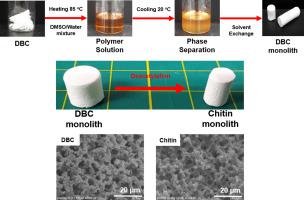Carbohydrate Polymers ( IF 10.7 ) Pub Date : 2021-09-20 , DOI: 10.1016/j.carbpol.2021.118680 Emil Hajili 1 , Zhicheng Suo 1 , Akihide Sugawara 1 , Taka-Aki Asoh 1 , Hiroshi Uyama 1

|
As a natural polymer, chitin has excellent biological properties such as biodegradability and immunological, antibacterial, and wound-healing activities and has numerous applications in cosmetics, drug delivery, and pharmaceuticals. Organic polymer monoliths have also drawn significant attention, owing to their high permeability, large surface area, and high mechanical strength. They are usually applied to separation, ion exchange, catalysis, and chromatography. We have previously prepared cellulose monoliths using biopolymers; however, because chitin possesses amide groups on its side chain, it is superior to cellulose for further chemical modification and applications. However, the utilization of chitin is restricted by its insolubility in water and common organic solvents. In this study, for the first time, a monolith was prepared by chemical modification of chitin using a thermally induced phase separation (TIPS) method. First, we prepared dibutyrylchitin (DBC) as a starting polymer that is soluble in organic solvents. To prepare the monolith, DBC was dissolved completely in dimethyl sulfoxide (DMSO) while heating, and deionized water was added to the solution. It was then cooled at 20 °C to form a monolith via phase separation. The porous morphology of the DBC monolith was altered by regulating the DBC concentration, DMSO/H2O ratio, and aging temperature. The DBC monolith was converted to a chitin monolith by the alkaline hydrolysis of butyryl ester. The successful hydrolysis of butyryl ester was confirmed by the disappearance of the peak at 1735 cm−1 in the FT-IR spectra, which is related to the ester moiety of DBC. The chitin monolith has the potential to be utilized under water flow for catalysis, metal capture from wastewater, dye sorption, and drug delivery systems.
中文翻译:

通过化学改性几丁质的热诱导相分离制备具有可控形态的几丁质整体
作为一种天然聚合物,甲壳素具有优异的生物降解性和免疫、抗菌、伤口愈合活性等生物学特性,在化妆品、药物输送和药物等方面具有广泛的应用。有机聚合物整体材料也因其高渗透性、大表面积和高机械强度而引起了广泛关注。它们通常应用于分离、离子交换、催化和色谱。我们之前使用生物聚合物制备了纤维素单块;然而,由于甲壳素在其侧链上具有酰胺基团,因此在进一步的化学改性和应用方面优于纤维素。然而,甲壳素的利用受到其不溶于水和常见有机溶剂的限制。在这项研究中,第一次,使用热诱导相分离 (TIPS) 方法通过对几丁质进行化学改性来制备整体材料。首先,我们制备了二丁酰几丁质 (DBC) 作为可溶于有机溶剂的起始聚合物。为了制备整料,DBC 在加热的同时完全溶解在二甲亚砜 (DMSO) 中,并向溶液中加入去离子水。然后将其在 20°C 冷却以通过相分离形成整体。通过调节 DBC 浓度 DMSO/H 来改变 DBC 整体的多孔形态 然后将其在 20°C 冷却以通过相分离形成整体。通过调节 DBC 浓度 DMSO/H 来改变 DBC 整体的多孔形态 然后将其在 20°C 冷却以通过相分离形成整体。通过调节 DBC 浓度 DMSO/H 来改变 DBC 整体的多孔形态2 O比,和老化温度。DBC 整体通过丁酸酯的碱性水解转化为甲壳素整体。FT-IR 光谱中 1735 cm -1的峰消失证实了丁酸酯的成功水解,这与 DBC 的酯部分有关。甲壳素整料具有在水流下用于催化、废水中金属捕获、染料吸附和药物输送系统的潜力。











































 京公网安备 11010802027423号
京公网安备 11010802027423号